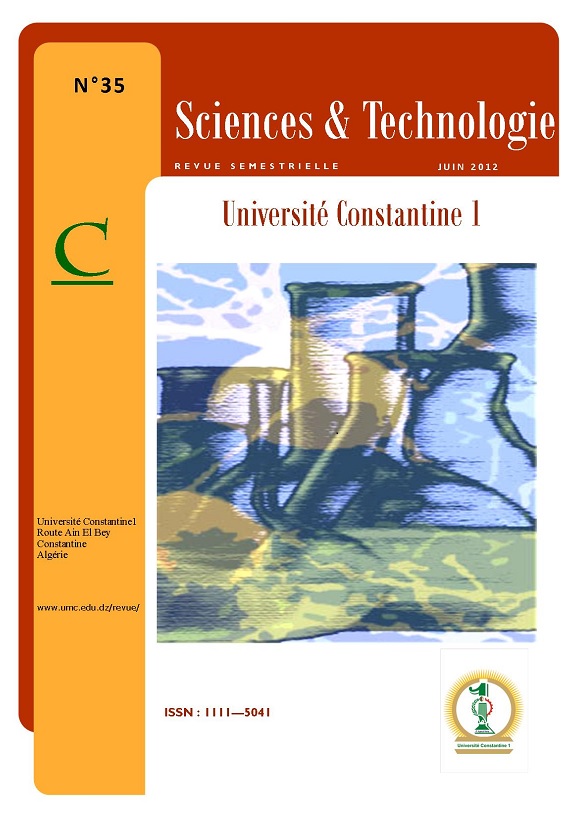CARACTERISTIQUES DE LA METALLOPROTEASE PRODUITE PAR ASPERGILLUS ORYZAESUR DECHETS D’ORANGES
Mots-clés :
Métalloprotéase, Aspergillus oryzae, déchets d’oranges, purificationRésumé
La protéase neutre (métalloprotéase) est produite par une moisissure mésophyle (Aspergillus oryzae) par fermentation d’un milieu à base de déchets d’oranges, enrichi par le « corn-steep liquor » et tamponné à pH 6 préalablement optimisé.Une activité protéasique de 2635 U et une biomasse de 15,42 g sont obtenues au bout de 52 heures de culture. La protéase est séparée des protéines non enzymatiques par une précipitation par le sulfate d’ammonium et une chromatographie sur Sephacryl S-200. La fraction active issue de cette dernière technique correspond à un rendement de 40% et un degré de purification de 16. Les caractéristiques de la protéase partiellement purifiée montrent qu’il s’agit d’une métalloenzyme (inhibition par l’EDTA) avec une constante d’inhibition de 25x 10-4 M. Son pH optimal est de 7 et sa température optimale de 40°C avec un temps de demi-vie de 8 minutes à 60°C. L’enzymeest également inhibée par le fer et le mercure. Elle est activée par le cobalt, le calcium, le manganèse et le nickel.
Références
SUMANTHA A, LARROCHE C and PANDEY A. Microbiology and Industrial Biotechnology of Food-Grade Proteases: A Perspective. Food Technol. Biotechnol. 44 (2). (2006); 211–220.
SANDHYA C ,SUMANTHA A ,PANDEY A . Proteases. In Enzyme
Technology, A. Pandey, C. Webb, C.R. Soccol, C. Larroche (Eds.), Asiatech Publishers Inc., New Delhi, India (2004) pp. 312–325.
DANSON M, HOUGH D. Les enzymes de l’extrême. Biofutur. (1998).
BLAIN J.A. Industrial enzyme production. The filamentous fungi.V(1), ed. J.E. SMITH and D.R.BERRY, LONDON. (1975). pp. 193-211.
LENOIR J, AUBERGER B. Les caractères du système proteolytique de Penicellium caseicolum.II- Caractérisation d’une protéase neutre. Lait, 568. (1977). Pp.471-491.
MECHAKRA A, AUBERGER B, REMEUF F, LENOIR J. (1999). Optimisation d’un milieu de culture pour la production d’enzymes protéolytiques acides par Penicillium camemberti. Sc. Aliments, 19. (1999). pp. 663-675.
SCHOMBURG Met SALZMAN. (Eds.) GBF- Gesellschaft fur. Biotechnologische Forschung. Enzyme Hand book5. (1991).
NAKADAI T, NASUNO Sand IGUCHI N. Purification and properties of neutral proteinase I from Aspergillus oryzae. Agr.Biol.Chem, 37(12), (1973). pp. 2695-2701.
NAKADAI T, NASUNO Sand IGUCHI N. Purification and properties of neutral proteinase II from Aspergillus oryzae. Agr. Biol.Chem, 37(12). (1973). pp. 2703-2708.
ZOUARI N, JAOUA S. Production and characterization of metalloproteases synthesized concomitantly with gamaendotoxin by Bacillus thuringiensissubsp- Kurstaki strain grown on gruel-based media. Enzymes Microbial Technol.25, (1999). pp. 364-371.
De AZERDO L.A.I, FREIRE D.M.G, SOARES R.M.A., LEITE S.G.F, COELHO R.R.R. Production and partial characterization of thermophilic proteases from Streptomyces sp. isolated from Brazilian cerrado soil. Enzyme and Microbial Technology 34. (2004). pp. 354–358.
GRIPON J. C, AUBERGER B, LENOIR J. Metalloproteases from Penicillium caseicolum and Penicillium roqueforti.Comparison of specifity and chemical characterization. Int. Biochem., 12. (1980) .pp.451-455.
CERNING J, GRIPON J.C, LAMBERT G, LENOIR J(1987). Les activités biochimiques des Penicillium utilisés en fromagerie. Lait. 67(1). (1987). pp. 3-39.
WEN-JENG WANG. Purification and functional characterization of AAV1, a novel P-III metalloproteinase, from Formosan Agkistrodon acutusvenom.Biochimie 89 (1). (2007). pp.105-115
YANG JEN-KNO, SHIHB ING-LUNG, TZENGE YEW-MIN, WANGA SAN-LANG. Production and purification of protéase from Bacillus subtilis that can deproteinize crustacean wastes. Enzymes Microbial Technol.26. (2000).pp. 406-413.
FUKE Yet MATSVOKA H. The purification and characterization of prolyl amino peptidase from Penicillium
camemberti. J. Dairy Sc., 76. (1993). pp. 2478-2484.
ALLISON Cand McFARLANE GT. Physiological and nutritional determinants of protease secretion by Clostridium spoorogenes: characterization of six extracellular proteases. Appl. Microbiol Biotechnol., 37. (1992). pp. 152-156.

